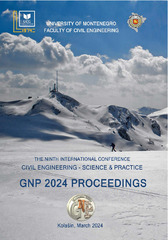Приказ основних података о документу
Experimental investigation of the construction joint in concrete ground floors
| dc.creator | Jakovljević, Isidora | |
| dc.creator | Gluhović, Nina | |
| dc.creator | Spremić, Milan | |
| dc.creator | Rajnović, Dušan | |
| dc.date.accessioned | 2024-03-11T10:57:29Z | |
| dc.date.available | 2024-03-11T10:57:29Z | |
| dc.date.issued | 2024 | |
| dc.identifier.isbn | 978-86-82707-36-3 | |
| dc.identifier.uri | https://grafar.grf.bg.ac.rs/handle/123456789/3469 | |
| dc.description.abstract | Ground floors of industrial buildings, fully supported on the ground or piles, are usually made of several concrete segments connected through free-movement construction joints. These joints should provide shear load transfer of the slab and minimise its vertical displacements while allowing slab horizontal movement to prevent damage due to concrete dry shrinkage. The construction joint “Dilat 08”, consisting of round steel dowels and steel formwork, was experimentally tested in a laboratory environment to determine its behaviour to shear load. The experimental double-shear setup consisted of three slabs connecting through the “Dilat 08” join system, with two side slabs fully supported on the base and the middle slab on which the vertical loading was applied. Specimens were formed with a gap of 10 mm between adjacent slabs to simulate the construction joint opening. Two construction joint orientations were investigated introducing the vertical load to the slab with a steel plate on the edge and to the slab with an angle profile on the edge. Experimental testing of both specimens resulted in construction joint failure due to concrete cracking around steel dowels, near the edges of the middle slab. The investigation confirmed that the joint orientation affects the joint shear response, demonstrating larger joint resistance when the steel plate is installed in the slab subjected to failure. Although contributing to the joint bending stiffness before formwork installation on the site, the horizontal leg of the angle profile decreases the joint resistance. Experimentally obtained joint resistance was compared to the design values of resistance according to Technical Report 34 and EN 1992- 4, highlighting a considerable difference between the two analytical approaches. The comparison between the “Dilat 08” and three types of free-movement joints available on the construction market showed that “Dilat 08” features larger resistance according to Technical Report 34, but it also weighs more. | sr |
| dc.language.iso | en | sr |
| dc.publisher | University of Montenegro, Faculty of Civil Engineering | sr |
| dc.relation | info:eu-repo/grantAgreement/MESTD/inst-2020/200092/RS// | sr |
| dc.rights | openAccess | sr |
| dc.rights.uri | https://creativecommons.org/licenses/by-nc-nd/4.0/ | |
| dc.source | Proceedings of The 9th International Conference "Civil Engineering – Science and Practice", Kolašin, 5-9th March 2024 | sr |
| dc.subject | construction joint | sr |
| dc.subject | free-movement joint | sr |
| dc.subject | steel dowel | sr |
| dc.subject | dowel bar | sr |
| dc.subject | industrial floor | sr |
| dc.subject | concrete slab | sr |
| dc.subject | shear failure | sr |
| dc.subject | dowel bending | sr |
| dc.subject | concrete bearing | sr |
| dc.subject | punching out | sr |
| dc.title | Experimental investigation of the construction joint in concrete ground floors | sr |
| dc.type | conferenceObject | sr |
| dc.rights.license | BY-NC-ND | sr |
| dc.citation.epage | 224 | |
| dc.citation.spage | 217 | |
| dc.identifier.fulltext | http://grafar.grf.bg.ac.rs/bitstream/id/12901/bitstream_12901.pdf | |
| dc.identifier.rcub | https://hdl.handle.net/21.15107/rcub_grafar_3469 | |
| dc.type.version | publishedVersion | sr |

